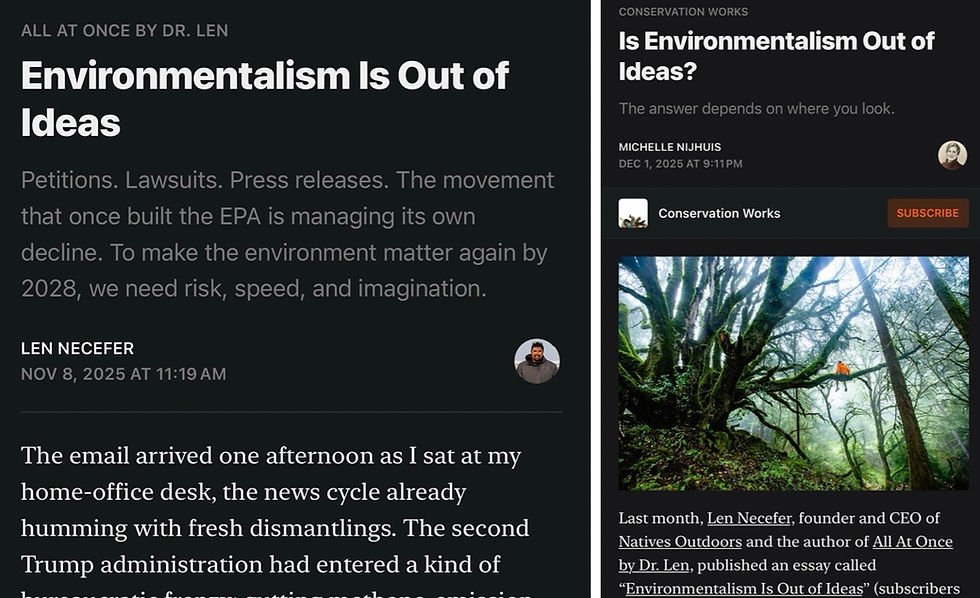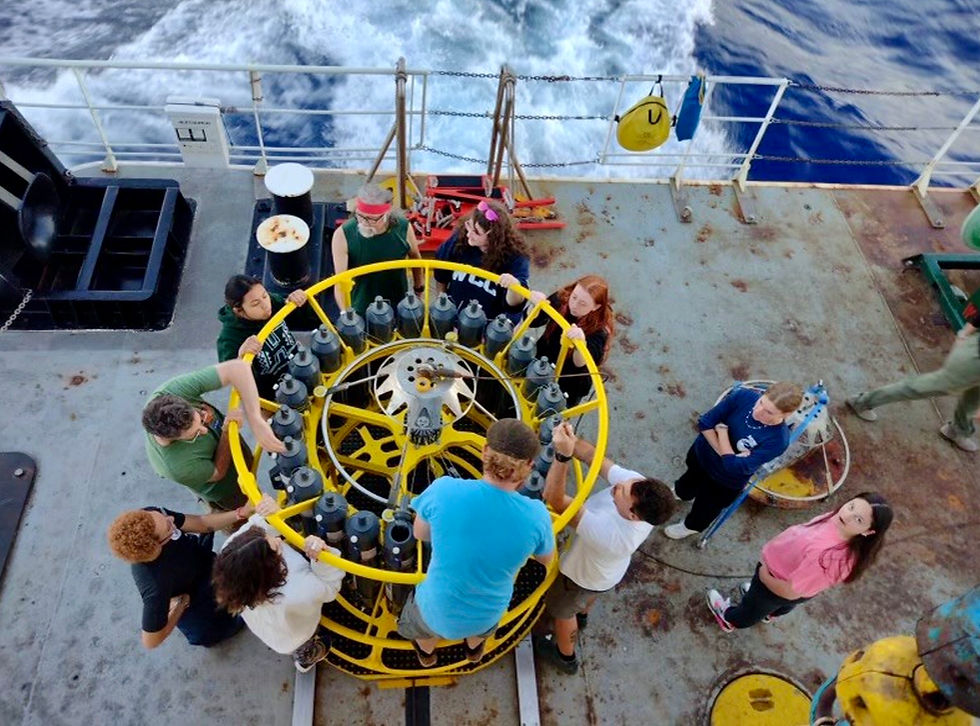The Fish in Our Feeds
- Ocean Hoptimism

- Oct 8
- 6 min read
What Online Aquarium Shopping Reveals and How Hobbyists Can Help Reefs
Scroll any big aquarium site and it feels like a candy shop: neon wrasses, cartoon-bright clownfish, tiny gobies with oversized personalities. But a new analysis of four major U.S. e-commerce platforms pulls back the curtain on where those fish come from and what their true costs can be, for reefs and for the people who rely on them.
This study tracked listings from 2021–2024 across 13 popular marine fish families. It logged each species’ source (wild-caught or captive-bred), price, and ecological traits, then cross-checked with FishBase and the IUCN Red List. The headline: 734 species were on offer, and about 89% were sourced exclusively from the wild. Forty-five species were of conservation concern, and 38 of those were only offered as wild-caught. On top of that, 100 species for sale weren’t even flagged as “in the aquarium trade” in the big global databases, meaning we’re flying blind in places where we really need good information.
And yet, woven through the findings is a real, workable path forward: powered by better data, smarter policy, and choices hobbyists can make today.

What the Researchers Looked At (In Plain English)
The team scraped listings from four large U.S. retailers and asked a few practical questions:
What’s being sold? Species, variants, families.
Where do these fish come from? Dealer-reported as wild-caught, captive-bred, or both.
How do prices behave? Which traits (size, schooling, depth, etc.) help predict price?
What’s the conservation picture? Are threatened or declining species showing up?
How complete is our public data? Do FishBase and IUCN even note that these species are traded?
They also compared species that were available both wild-caught and captive-bred to see how price differed between the two sources.
What They Found
Wild dominates. Of the 734 species identified, 655 were sold only as wild-caught. Just 21 species were exclusively captive-bred, and 58 had both options.
Conservation flags. 45 species were either listed as threatened or had declining population trends. Thirty-eight of those were offered only as wild-caught.
Data gaps. 100 species being sold online weren’t listed as part of the aquarium trade by FishBase or IUCN, evidence that our official tracking is incomplete.
Price patterns. Smaller, shallow-living, schooling species, and fish labeled wild-caught, tended to be cheaper. Cheap isn’t automatically bad, but lower prices + high demand can mean more fishing pressure on similar species.
Aquaculture can compete. For the 58 species with both options available, captive-bred fish averaged ~28% cheaper than wild-caught. That’s a big deal: it shows that in many cases, aquaculture isn’t just an ethical upgrade, it’s an economic one, too.
Why It Matters (For Reefs and for People)
Most marine ornamentals are collected in tropical countries (think Indonesia, the Philippines, and beyond) where livelihoods are tied to the sea. When the trade is poorly monitored or badly managed, wild capture can stress fragile reef communities, harm non-target species, and amplify the risks for fish already struggling in the wild. There’s also the long supply chain to consider: capture methods, handling, shipping, and survival all matter.
At the same time, the trade supports coastal income. A blunt, one-size-fits-all shift to large-scale aquaculture in importing countries could disrupt livelihoods in source communities and concentrate profits far from the reefs. The question isn’t “wild or captive-bred.” It’s how to make both work for reefs and for people.
Another complication: mislabeling happens. Retailer-reported sourcing can be wrong (accidentally or otherwise). Without transparent, verifiable traceability, even well-meaning buyers struggle to choose responsibly. That’s fixable, but it requires standards and accountability.
The Silver Lining... and a Way Through
Here’s the hopeful part: the study points to levers that actually move.
Aquaculture is already price-competitive for many species. If captive-bred individuals are often less expensive than wild-caught, scaling production for high-demand species can reduce pressure on reefs without pricing out hobbyists.
We know where to focus. The data indicates specific species where management, aquaculture investment, and clear labeling would have outsized benefits, especially those with conservation flags.
Consumer power is real. Prices track traits. That means clear labels, credible sourcing, and simple “buy this, not that” guidance can nudge demand toward sustainable choices.
Data gaps are map gaps. Identifying 100 “invisible” traded species gives agencies and researchers an immediate to-do list. Better listings, better import codes, better traceability, better policy.
A balanced path respects people and places. Responsible wild fisheries (with monitoring, limits, and community benefits) plus expanded aquaculture (with support, training, and fair markets) can share the load and keep incentives aligned with healthy reefs.
Home Aquariums: Part of the Problem or Part of the Solution?
Let’s say the quiet part out loud: home aquariums are gateways. A lot of marine biologists, aquarists, veterinarians, and conservationists started with a single tank and a single fish that lit up their curiosity. Tanks can be classrooms, empathy machines, and lifelong bridges into ocean science.
Yes, captivity raises hard questions. That’s exactly where good husbandry and modern aquaculture come in: improving welfare, reducing wild extraction, and helping hobbyists become stewards instead of bystanders. The hobby isn’t going away; the opportunity is to evolve it.
Practical Guidance for Current (and Future) Marine Hobbyists
If you already keep a saltwater tank, or you’re thinking about it, here’s how to align your passion with reef health:
Choose captive-bred whenever possible. Especially for high-demand species. Captive-bred fish often adapt better to tanks, are disease-screened, and, per this study, can be more affordable.
Ask for proof of source. Look for clear, verifiable labeling. Favor vendors who can explain provenance, collection methods, and holding practices, and who welcome questions.
Pick species that thrive in captivity. Avoid “expert only” or poor-survival species. Research adult size and behavior; don’t buy a fish that will outgrow your tank.
Never release aquarium fish into the wild. If you need to rehome, use reputable rehoming networks, local clubs, or the original vendor. Never local waters.
Quarantine new arrivals. A simple quarantine setup reduces disease spread to your display tank and protects the broader supply chain by limiting losses.
Support responsible retailers. Reward shops and online sellers that invest in aquaculture partnerships, transparent sourcing, and good animal care.
Mind the whole footprint. Right-size your tank, optimize filtration, use efficient equipment, and manage water changes responsibly. Reef health is about energy and water too.
Be coral-careful. If you keep corals, favor aquacultured frags and avoid wild colonies unless you have high confidence in the collection and permits.
Learn, then share. Your tank can be a micro-museum. Teach friends and kids about reef food webs, responsible sourcing, and why traceability matters.
Vote with your wallet and your voice. Ask platforms to display source, location, and collection method by default. Encourage better labeling and third-party verification.
What Industry and Policymakers Can Do Next
Fixing the aquarium trade doesn’t mean reinventing the wheel. It means tightening the bolts that already exist. The first bolt is traceability. We need clearer import codes, batch tracking, and public dashboards that show what species are being traded, from where, and in what volume. That kind of transparency would turn oversight from a detective game into real management.
Next comes investment where it counts. Agencies, funders, and even private industry can help bring more species into aquaculture, especially high-demand or high-risk fish, by supporting research, training, and technology development. If aquaculture can meet the market where it already is, we protect reefs and livelihoods at the same time.
For species that will continue to come from the wild, the answer isn’t prohibition, it’s responsible management. Science-based harvest limits, reduced bycatch, local monitoring, and fair benefit-sharing can align fishing incentives with reef health, ensuring that communities and ecosystems both thrive.
Then there’s the issue of trustworthy ecolabels. A sticker only matters if it’s backed by something real. Transparent standards, independent audits, and retail participation can make sustainable sourcing more than a marketing slogan.
Finally, it’s time to close the data loop. Global databases like FishBase and the IUCN Red List should reflect what’s actually being traded, so scientists and policymakers can see red flags early, before species slide from “common” to “concern.”
Bottom Line
This study isn’t a takedown of the aquarium hobby; it’s a blueprint. It shows where pressure is building, where information is missing, and, crucially, where solutions already pencil out. Aquaculture is often cheaper. Consumers care and can choose better. Communities can benefit when trade is managed well. And tanks at home can keep the next generation of reef stewards curious, skilled, and connected.
If you love your fish, you already love reefs. Let’s make sure the way we buy, keep, and talk about marine life helps those reefs recover.
The future of the hobby can be the future of reefs: bright, diverse, and resilient. If we build it that way.



Comments